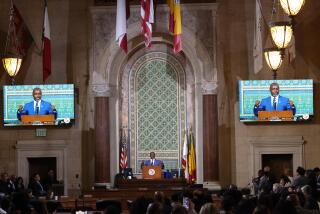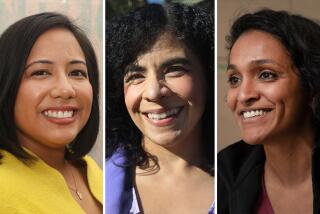Claremont Council : 6-Candidate Race Sets Off a Volcano of Rhetoric
- Share via
CLAREMONT — This normally quiet, stable community of 34,000 has virtually exploded with debate since campaigns for the April 8 City Council election began a few months ago.
The one incumbent and five challengers have focused their attention on the last parcels of land in the seven-square-mile city that remain undeveloped, traffic congestion and what some have called a cumbersome bureaucracy that discourages development. But those subjects only begin the list.
Challenger Wei Liang Yu, a pediatrician, is sharply critical of the bulky trash bins the city introduced a few years ago to replace the more familiar but costlier system that utilized smaller, privately owned garbage cans. He says the city’s bins are too big and too heavy, and hopes the voters will agree.
“We were given big garbage cans that we have to roll out onto the street,” said Yu, 67, who has lived in Claremont for 18 years. “Sixty or 75 gallons. Many elderly people find it difficult.”
Wants Cultural Events
Yu also said the city should sponsor more cultural events.
Another challenger, Claremont Planning Commissioner Diann Ring, said one of her pet peeves is the timing of council meetings. She said the 5 p.m. meetings start too early to be convenient for working people, and that they often last until well after 10:30 p.m.
“You always run a danger with any public meeting after 10:30 because people can’t stay,” said Ring, 43, who has lived in Claremont for 13 years. “A meeting like that isn’t really public. A meeting at 5 o’clock is not public either.”
Although perhaps two of the more unusual concerns, the issues illustrate an almost-anything-goes campaign that has touched on nearly every element of city government. The six candidates are vying for three seats.
Most of the challengers have lived in Claremont for a decade or more and had never sought public office.
The only challenger who has run previously is Alexander Hughes, 48, an assistant superintendent in the Claremont Unified School District who lost a bid for City Council two years ago and is now a planning commissioner. Hughes said his reasons for running are much the same as they were the last time: he has lived in the community for 20 years and his service on two city panels--the Architectural Commission and the Planning Commission--have made him acutely aware of the city’s needs.
Abandoned Center
Hughes said he is particularly interested in the development of an almost abandoned shopping center in southern Claremont known as Cambridge Square, an eyesore for nearby residents.
“It’s crucial how we come across to people who live in that area,” Hughes said. “We need to make them feel that we think they’re important.”
Of three incumbents whose terms expire on April 15, only attorney Terry P. Fitzgerald, who has lived in the city for seven years, is seeking reelection. Fitzgerald, 38, who is seeking a second term, said the fact that she could become the council member with the most experience is a key element in her campaign.
“It’s really important for continuity,” Fitzgerald said of Her bid for reelection. “The two people who will be left on the council after the election (Judy Wright and Bill McCready, who are not up for reelection) have only served for two years. I will have four years.”
Topping Fitzgerald’s list of priorities is the completion of an office complex proposed by a subsidiary of World Vision International, a religious organization involved in international relief efforts. World Vision eventually hopes to relocate its headquarters from Monrovia to a spent gravel quarry in Claremont.
Five-Month Delay
Because building in the quarry would pose some unusual architectural problems, the proposal by Claremont Facilities Corp., a subsidiary of World Vision, was sent back to the Planning Commission by the City Council for reworking. After a five-month delay, the council agreed two weeks ago to approve a general plan and make the necessary zoning change, but not without a number of carefully detailed building requirements.
The city and Claremont Facilities are now working toward a specific plan and a development agreement for the project. The for-profit Claremont Facilities was created as a conduit through which the nonprofit World Vision could secure a building site for its new headquarters, a corporate spokesman said.
The five-month delay led some candidates to question whether the city’s regulations are so stringent and the approval process so lengthy that some developers might take their projects to less restrictive cities.
Challengers Jess Swick, a local insurance salesman, and Nick Presecan, a civil engineer for a private firm, along with Hughes and Fitzgerald, said the planning process should be streamlined. Swick and Presecan both said the council should be more accommodating to developers to keep the city from being branded “anti-business.”
Swick, 36, who said he has gotten to know many area businessmen in the 10 years he has sold insurance in the city, said the planning and approval processes could be better organized to permit faster processing.
“Claremont needs to be more aggressive to bring business into town,” Swick said. “Some of the people I know in the business world say they can’t get anything through the Claremont council.”
Swick said that during his campaign, he has emphasized his knowledge of the business community and his ability to see both sides of issues.
Would Speed the Process
Presecan, 45, also spoke of speeding up the approval process, and said his scientific and environmental engineering background, as well as 10 years of community activism, would help the council understand the essence of technical problems more quickly, allowing the city staff to better spend its time. He is on the city’s Architectural Commission.
“The council people really aren’t technically trained,” Presecan said. “There seems to be a concern by a lot of people that the council takes a long time to implement solutions to problems. One explanation is they confuse indecision with caution.”
Yu and Ring, however, said the system works well and, though sometimes tedious, will ensure that the city’s remaining developments are executed properly.
Ring said approving World Vision’s project took so long precisely because the process works well, and that major flaws in the project that would have been revealed years later have already been ironed out.
“People do feel they can make a difference,” Ring said. “They can come to City Hall and yell and scream and it works.”
Traffic Congestion
Each of the candidates also said traffic congestion in the city is a problem, largely because Indian Hill Boulevard is the only street leading directly into Claremont from Interstate 10. Ring, Hughes and Swick also mentioned concerns about an undeveloped north Claremont area known as the Hillside because it abuts foothills of the San Gabriel Mountains. The three said that deciding whether the area should be developed and how will be among the council’s most important decisions in the next few years.
While these and other issues have stimulated debate among the candidates, however, the two outgoing incumbents said that during their years on the council the same issues have come before them more than once. They said that the new council members, whoever they may be, are sure to see the problems in a new light, unspoiled by too great a familiarity.
Mayor Enid Douglas, 59, said her eight years on the council and eight years on the Planning Commission before that are enough, and that it is time to give someone else a chance. Douglas, a history professor at Claremont Graduate School, also said she wants to devote more time to her work.
Councilman Gordon Curtis, 56, said 21 years of involvement in city business--the last four as a councilman and earlier as a member of various commissions--has been extremely time-consuming and that the same issues come up again and again. He said reading 40-year-old news clippings has shown him that Claremont’s problems--land use and how much commercial development the city could support--are not new.
“The problems they had in the ‘40s are the same problems we have now,” Curtis said.
More to Read
Sign up for Essential California
The most important California stories and recommendations in your inbox every morning.
You may occasionally receive promotional content from the Los Angeles Times.










